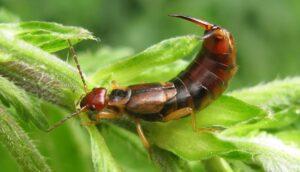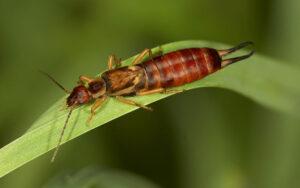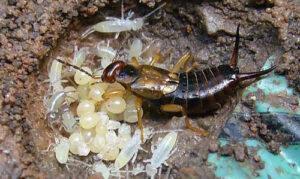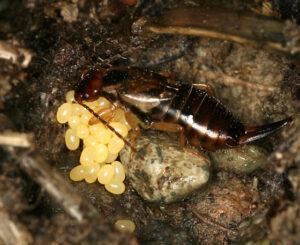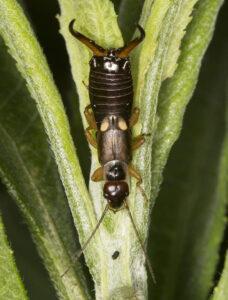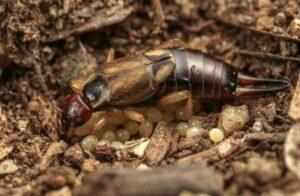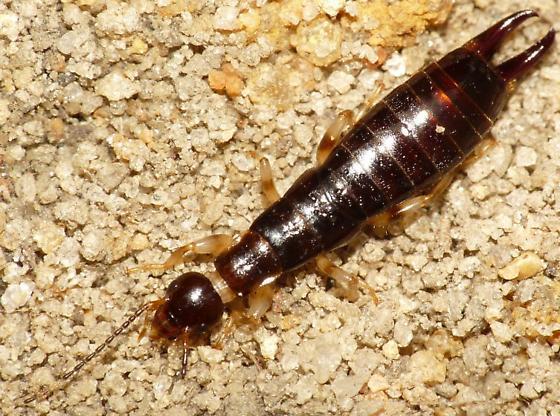European Earwig (Forficula auricularia)
Updated on
17/11/2022The European earwig is a common household pest in North America. The species name, auricularia, refers to the appearance of the insect’s unique hindwings that resemble a human ear when unfolded. It causes serious damage to economic crops. It invades crevices in homes, and eats and contaminates pantry food.
Scientific Classification
- Class:Insecta
- Order:Dermaptera
- Family:Forficulidae
- Genus:Forficula
- Species:F. auricularia
Conservation Status
Description
The European earwig is reddish-brown in color. It has a flattened, elongated body with thin, beaded antennae, shield-shaped pronotum, and a pair of wings. The bottom of the flexible abdomen bears a pair of pincers of forceps that are big and extremely curved in males and straight in females. They are 12-15 mm in size.The lobed 2nd tarsal segment extends distally below the 3rd one.
They spend the day in cool, dark, hidden places like fruits, flowers, and wooden crevices. Though the wings are fully developed, they are pretty weak and rarely used. So, they are carried from one place to another via clothing or commercial products like newspaper bundles, ornamental shrubs, lumber, etc.
Distribution: Europe, North America, western Asia, and possibly northern Africa.
Habitat: Cool, moist places with an optimum mean growth temperature of 75°F (24°C). Their daily incidence in a year is linked to weather parameters like wind velocity, temperature, and easterly winds. Hibernating adults can tolerate low temperatures but find it difficult to survive in poorly drained soils such as clay. To escape excessive moisture, they seek the southern sides of well-drained slopes. They also live in hollow flower stems in poorly drained soils.
Do They Bite/Sting: No.
Lifespan: 1 year on average.
Predators: Parasitoid flies, some fungi, and many birds.
Behavior and Characteristics
Diet
They are active mainly at night, foraging, with their food varying from plant matter to small insects. Though omnivorous, they are not predators but act as scavengers.
Bite
It cannot bite but can pinch a person at the most with its pincers and hold on tight without breaking any skin. It is not painful in most cases.
Life Cycle
1. Egg Stage
The pearly white eggs are oval to elliptical in shape. They can resist cold and heat damage.
2. Nymph Stage
The nymphs look similar to the adults, but their wings are either absent or small, and they are of a lighter color. They pass through 4 stages and don’t leave the nest till the 1st molt is over.
3. Adult Stage
A male finds a female with his sense of smell. Then he slips his pincers below the tip of her abdomen and stays in that position for many hours if not disturbed. A single mating event can make the female lay fertilized eggs.
They overwinter 5 mm below the ground surface. In autumn, a clutch of around 50 eggs is laid by a female in an underground nest. Then she enters a dormant state and remains nested with the eggs. She cares for them and the young who emerge in spring till they mature in about a month. The female can lay a second brood in a season, with all the young reaching maturity by August-end.
Getting Rid of European Earwigs
High population levels of the pest damage crops, fruit orchards, and flowers. Their annoying tendency to gather near houses and foul odor is also a nuisance. Hence, their control is attempted by introducing natural enemies in their habitat and applying insecticides. Having said that, they are also beneficial as they help humans get rid of other agricultural pests. They usually don’t cause much damage to crops if there is abundant insect prey.
Source
media.kidadl.com, wythamwoods.ox.ac.uk, entnemdept.ufl.edu, bugguide.net, ucanr.edu, objects.liquidweb.services,




